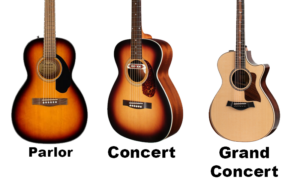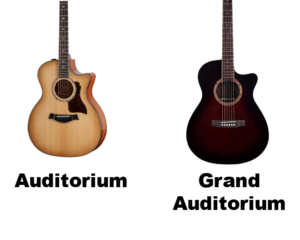Uncategorized
Striking the Right Chord: Unveiling the Art of Guitar Pick Thickness
In the enchanting realm of music, every choice a musician makes contributes to the symphony of sound they create. When it comes to playing the guitar, one seemingly small decision—the thickness of the guitar pick—can have a significant impact on the tone, technique, and overall experience. Whether you’re a seasoned strummer or a budding guitarist, understanding the nuances of guitar pick thickness is a key step in shaping your sonic journey. This article will take you on a harmonious exploration of the world of guitar pick thickness, revealing how this seemingly modest piece of plastic can wield a profound influence on your musical expression.
The Spectrum of Thickness
Guitar picks come in a variety of thicknesses, ranging from paper-thin to heavy-duty. The measurement of pick thickness is often denoted in millimeters, with thinner picks having lower measurements and thicker ones having higher measurements. As a guitarist, your choice of pick thickness can influence several aspects of your playing:
1. Tone and Texture: The thickness of your guitar pick can significantly alter the tone produced by your instrument. Thinner picks tend to produce a brighter, crisper sound with more high frequencies, while thicker picks can result in a warmer, mellower tone with enhanced low frequencies. The texture of the pick, whether smooth or textured, can further affect the attack and resonance of each note.
2. Strumming and Picking Technique: The thickness of the pick can influence your strumming and picking technique. Thinner picks are well-suited for strumming and creating a fluid motion across the strings. On the other hand, thicker picks provide more resistance, making them ideal for precision picking and intricate patterns.
3. Articulation and Control: Thinner picks offer greater flexibility, allowing for easier bending and vibrato techniques. Thicker picks provide enhanced control and articulation, making it easier to execute precise and accurate note changes.
4. Speed and Shredding: For guitarists who indulge in speedy solos and shredding, the thickness of the pick can impact your ability to glide across the strings effortlessly. Thinner picks may be favored by those seeking rapid picking, while thicker picks can offer stability and control at high speeds.
Finding Your Perfect Match
Choosing the right pick thickness is a personal journey that depends on your playing style, musical preferences, and the sound you wish to achieve. Here are some tips to help you find your perfect match:
1. Experimentation: Begin by experimenting with picks of different thicknesses. Play the same passage using picks of varying thicknesses to compare the tonal differences and how each pick feels in your hand.
2. Genre and Style: Consider the genre of music you enjoy playing. Thicker picks may be preferred for genres like rock, metal, and jazz, while thinner picks could be suitable for folk, pop, or acoustic styles.
3. Comfort and Feel: Pay attention to how comfortable each pick feels in your hand. Some guitarists prefer the flexibility of thinner picks, while others find the stability of thicker picks more suitable.
4. Adaptation: Keep in mind that your preference for pick thickness may evolve over time. As your playing style and technique develop, you might find that your ideal pick thickness changes as well.
Conclusion
The world of guitar pick thickness is a captivating journey that invites you to explore the realms of tone, technique, and personal expression. As you strum, pluck, and unleash melodies upon the strings of your guitar, remember that the thickness of your pick is a silent collaborator in the creation of your musical masterpiece. Whether you’re unleashing powerful riffs, crafting delicate melodies, or embarking on an electrifying solo, the pick you choose holds the power to shape the very essence of your sound. So, venture forth with curiosity and an open ear, and let the quest for the perfect guitar pick thickness be a delightful symphony of discovery in your musical odyssey.
Uncategorized
Acoustic Guitar Sizes: Finding Your Perfect Fit
Have you ever wondered how the size of an acoustic guitar affects its sound? From the intimate, focused tones of a parlor guitar to the deep, resonant sound of a jumbo, the size and shape of an acoustic guitar can have a profound impact on its sonic characteristics.”
In this article, we’ll explore acoustic guitar sizes, their variations, and how to choose the perfect size that suits your needs.
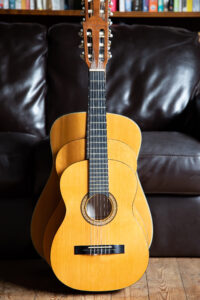 Understanding Acoustic Guitar Sizes: A Musical Puzzle
Understanding Acoustic Guitar Sizes: A Musical Puzzle
Acoustic guitar sizes refer to the dimensions and proportions of the guitar body, which significantly influence the instrument’s tonal characteristics, projection, and playability.
Just like pieces of a musical puzzle, different sizes create distinct voices that cater to various playing styles and preferences.
The Spectrum of Acoustic Guitar Sizes
Acoustic guitars come in several sizes, each with its unique qualities and attributes. Let’s explore some common acoustic guitar sizes and their defining features:
-
-
Parlor Guitar: The parlor guitar is petite and charming, making it an ideal companion for intimate settings.
The name comes from the rooms in which the guitar was typically played in the late 19th century.
Some famous musicians who have been known to use the parlor guitar are, Eric Clapton, Mark Orton, Ed Sheehan, and John Mayer
Its smaller size results in a focused and balanced sound, perfect for fingerpicking and folk music.
-
Concert Guitar: Slightly larger than the parlor guitar, the concert guitar offers enhanced projection and volume. It strikes a balance between portability and sound, making it versatile for various genres.
It is often used in classical music and flamenco music with its full sound.
-
Grand Concert Guitar: With a larger body than the concert guitar, the grand concert guitar boasts a fuller sound and improved tonal complexity.
A popular choice for those who have a smaller stature and require an instrument that’s built to a shorter scale. Great choice for traveling musicians who often play live performances.
It’s suitable for fingerstyle playing and intricate arrangements.
-
Auditorium Guitar: The auditorium guitar, also known as the orchestra model (OM), features a well-rounded sound with a pronounced midrange.
More shallower than the dreadnought and narrower in width than a concert guitar. An Auditorium guitar brings the body closer to the player, making it feel more intimate and comfortable for stage use.
Some famous musicians who play it include Ed Sheeran, John Mayer, and Eric Clapton.
-
Grand Auditorium Guitar: Expanding on the auditorium guitar’s design, the grand auditorium guitar offers a versatile sound profile with enhanced bass response and overall volume.
It is a versatile mid-sized guitar that is a good choice for those who want a single guitar to travel with. The tone is great for strumming and picking. It performs well on stage and in the studio.
It suits a wide range of musical genres.
-
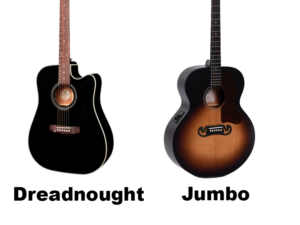 Dreadnought Guitar: The Dreadnought is a true icon, known for its bold and powerful sound. Its large body produces a strong bass response, making it ideal for strumming and vocal accompaniment.
Dreadnought Guitar: The Dreadnought is a true icon, known for its bold and powerful sound. Its large body produces a strong bass response, making it ideal for strumming and vocal accompaniment.This guitar is known for its powerful voice and lower-mid-rich tones that make it a favored choice for country artists. Although it is a popular choice for musicians of all genres.
Some famous musicians who play the dreadnought guitar include Hank Williams Jr, Elvis Presley, Keith Richards, Thom Yorke, and Kurt Cobain.
The original dreadnought guitars were made for the Oliver Ditson Company and featured mahogany backs and sides and spruce tops.
-
Jumbo Guitar: The jumbo guitar lives up to its name with a massive body that delivers robust volume and a deep bass presence.
This is the largest of the guitar family with a deeper body than the popular dreadnought. The body is wider and deeper than traditional acoustic guitars, which gives them a unique appearance.
Jumbo’s are well suited to rhythm guitarists in country and folk rock, and produce a deep rich sound favored by heavy strummers. Some famous musicians who play this guitar are Elvis Presley, George Harrison of the Beatles, Neil Young, Sheryl Crow, and Pete Townshend of The Who.
Choosing the Right Acoustic Guitar Size for You
Selecting the right acoustic guitar size involves considering factors such as playing style, comfort, and tonal preferences. Here are some steps to guide you on your quest:
-
Identify Your Playing Style: Determine whether you lean towards fingerpicking, strumming, or a mix of both. Different sizes excel in different playing styles, so choose one that complements your technique.
-
Consider Body Comfort: Hold and play guitars of various sizes to assess comfort. A guitar that fits well against your body ensures a pleasant playing experience, especially during extended sessions.
-
Evaluate Sound Preferences: Listen to the sound produced by different acoustic guitar sizes. Pay attention to tonal qualities, such as warmth, brightness, and projection, to find the one that resonates with your musical taste.
The Influence of Acoustic Guitar Sizes on Music
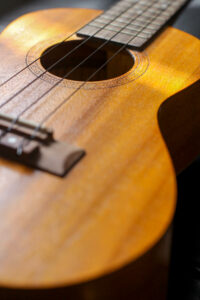 Acoustic guitar sizes and shapes can have a significant impact on the sound of the instrument.
Acoustic guitar sizes and shapes can have a significant impact on the sound of the instrument.The size of the guitar body type also relates to the volume of air within the instrument. Changes to the air capacity of the body will emphasize specific frequencies. A smaller body will have a more focused sound centered on higher frequencies, while a larger body will produce deeper low-end frequencies.
Body dimensions can provide some indication of the tone you might expect, but other factors exert a profound influence, too. Much depends on the tonewoods used to construct the body and the shape, size, and layout of the braces.
Finding Harmony in Acoustic Guitar Sizes
By delving into the nuances of size, sound, and playability, you’ve gained insights that will guide you toward the perfect fit for your musical aspirations.
As you continue your exploration, remember that each acoustic guitar size has its own unique voice and character. Embrace the joy of trying different sizes, celebrate the nuances of their sounds, and let your heart lead you to the one that resonates with your musical soul.
-
Uncategorized
Unveiling the Enchanting CM7 Guitar Chord: Your Key to Musical Expression
Hello, fellow guitar enthusiasts and music aficionados! Are you ready to delve into the captivating world of the CM7 guitar chord? Today, we’re embarking on a melodic journey that unveils the beauty and versatility of the CM7 chord – a harmonious gem that adds depth and sophistication to your musical repertoire. Whether you’re a budding guitarist eager to expand your chord knowledge or a curious soul seeking to understand the intricacies of harmony, this guide will introduce you to the enchanting universe of the “CM7 Guitar Chord.” So, pick up your guitar, find a comfortable spot, and let’s explore the harmonious tapestry of musical expression and creativity!
Discovering the CM7 Guitar Chord: A Harmonious Gem
Imagine the CM7 chord as a musical gem that radiates elegance and charm. This chord’s unique tonal quality infuses your music with a sense of warmth and richness, making it a versatile choice across various musical genres. Just like a painter mixing colors on a palette, the CM7 chord allows you to blend notes and create harmonies that resonate with emotion and creativity.
Mastering the CM7 Guitar Chord: Crafting Melodic Brilliance
Let’s dive into the mechanics of forming the CM7 chord on your guitar. Follow these steps:
1. Finger Placement: Begin by placing your index finger on the 1st fret of the B string (the second thinnest string), marking the root note (C).
2. Middle Finger: Position your middle finger on the 2nd fret of the D string (the fourth thickest string), forming the major third (E).
3. Ring Finger: Place your ring finger on the 3rd fret of the A string (the fifth thickest string), creating the perfect fifth (G).
4. Pinky Finger: Add your pinky finger to the 4th fret of the high E string (the thinnest string), completing the chord with the major seventh (B).
5. Strumming: Strum from the A string (the fifth thickest string) down to the high E string (the thinnest string), omitting the low E string (the thickest string) for a cleaner sound.
6. Sound Check: Strum the strings individually to ensure each note rings out clearly. Adjust finger placement if needed for a resonant sound.
Exploring CM7 Guitar Chord Variations: Adding Flair
While the CM7 chord is inherently elegant, you can add variations to elevate its sonic possibilities. Here are a couple of ways to experiment:
1. Add Arpeggios: Instead of strumming all the strings at once, try playing the notes of the CM7 chord individually in a sequence to create arpeggios that cascade like gentle waterfalls.
2. Fingerstyle: Experiment with fingerstyle picking to add intricate patterns and dynamics to your CM7 chord progressions.
The CM7 Guitar Chord in Action: Musical Styles
The CM7 chord’s rich and lush quality makes it a favorite choice for songs that evoke emotions and convey depth. Here are a few popular songs that feature the CM7 chord:
1. “Don’t Know Why” by Norah Jones: The CM7 chord contributes to the jazzy and soulful atmosphere of this timeless ballad.
2. “Tears in Heaven” by Eric Clapton: The CM7 chord adds a touch of melancholy and introspection to the song’s heartfelt melody.
Tips for Mastering the CM7 Guitar Chord
As you dive into the world of the CM7 chord, consider these tips to enhance your playing:
1. Practice Chord Changes: Work on transitioning smoothly between the CM7 chord and other chords to improve your overall playing fluency.
2. Experiment with Strumming Patterns: Try different strumming patterns to add rhythmic interest and variety to your CM7 chord progressions.
3. Use a Metronome: Practice with a metronome to develop a steady sense of rhythm and timing.
Conclusion: Embrace the Beauty of the CM7 Guitar Chord
Congratulations, you’ve embarked on a harmonious journey through the captivating universe of the CM7 guitar chord. As you strum, experiment with variations, and play songs, you’ll discover the power of this chord to infuse your music with elegance, emotion, and depth. Keep practicing, keep exploring, and keep embracing the enchanting allure of the CM7 chord. It’s your key to a world of musical expression, where each note resonates with grace and sophistication. So, pick up your guitar, let your fingers dance across the strings, and let the captivating world of the CM7 guitar chord lead you toward a realm of melodies that stir the heart and elevate the soul, one harmonious note at a time!
Uncategorized
Guitar Finger Exercises: Strengthening Your Musical Fingers
Playing the guitar is like embarking on a captivating musical journey where your fingers dance across the strings, weaving melodies that resonate with the heart. To embark on this journey with confidence and finesse, it’s essential to develop strong and agile fingers. Guitar finger exercises are the key to building finger strength, dexterity, and control, allowing you to navigate the fretboard with ease and create beautiful music. In this article, we’ll explore the world of guitar finger exercises, discover their benefits, and provide you with practical exercises to enhance your playing. Get ready to unlock the secrets of guitar finger exercises and take your musical skills to new heights!
Understanding the Importance of Guitar Finger Exercises
Guitar finger exercises are specialized drills designed to target specific finger movements and muscle groups used in guitar playing. These exercises not only improve your finger strength but also enhance your ability to execute techniques such as chords, scales, and intricate melodies. By incorporating regular finger exercises into your practice routine, you’ll lay the foundation for smoother transitions, cleaner notes, and overall improved guitar playing.
Benefits of Guitar Finger Exercises
Mastering guitar finger exercises offers several benefits for aspiring guitarists:
1. Finger Strength: Guitar finger exercises help develop the strength of your fingers, enabling you to press down on the strings with precision and clarity.
2. Dexterity: These exercises enhance finger dexterity, allowing you to navigate the fretboard smoothly and execute complex patterns with ease.
3. Coordination: Guitar finger exercises improve finger coordination, enabling you to play multiple strings and frets simultaneously while maintaining accuracy.
4. Technique Enhancement: Practicing finger exercises refines your playing technique, ensuring that each note sounds clean and distinct.
Practical Guitar Finger Exercises
Here are some practical guitar finger exercises that you can incorporate into your practice routine:
1. Finger Crawls: Place your fingers on adjacent frets (e.g., index on 1st fret, middle on 2nd, ring on 3rd, and pinky on 4th). Starting from the low E string, play each string individually, lifting and placing your fingers sequentially. Move up one fret at a time and then reverse the process.
2. Spider Walks: Position your fingers on non-adjacent frets (e.g., index on 1st fret, middle on 3rd, ring on 2nd, and pinky on 4th). Similar to finger crawls, play each string individually, moving up the fretboard one string at a time and then reversing the process.
3. Chord Transitions: Select a chord progression (e.g., G – C – D) and practice switching between the chords smoothly and without pause. Focus on lifting and placing your fingers as efficiently as possible.
4. Scale Runs: Choose a scale (e.g., the C major scale) and play the scale ascending and descending using alternate picking. Focus on maintaining a consistent rhythm and clean articulation.
Incorporating Finger Exercises into Your Practice Routine
Here’s how you can integrate guitar finger exercises into your practice routine:
1. Warm-up: Begin your practice session with a brief warm-up, gently stretching and flexing your fingers. This prepares your fingers for the exercises ahead.
2. Focused Sessions: Dedicate a portion of your practice time to specific finger exercises. Start with a slow tempo and gradually increase your speed as you become more comfortable.
3. Consistency: Consistency is key. Set aside a few minutes each day to work on finger exercises. Over time, you’ll notice significant improvements in your finger strength and agility.
Conclusion: Your Fingers, Your Musical Canvas!
Congratulations, you’ve embarked on the path of mastering guitar finger exercises! By incorporating these exercises into your practice routine, you’ve equipped yourself with the tools to create music that resonates with clarity and finesse. Whether you’re strumming chords, picking intricate melodies, or exploring the depths of scales, strong and agile fingers are your passport to a world of musical possibilities.
As you continue your musical journey, remember that practice and dedication are essential to honing any skill. Embrace the joy of learning, celebrate your progress, and let your passion for music guide you forward. With consistent effort and a love for playing, you’ll find yourself navigating the fretboard with confidence, creating captivating melodies, and expressing your unique musical voice.
Guitar finger exercises are just the beginning of your musical odyssey. As you delve deeper into the world of guitar playing, you’ll encounter a myriad of techniques, chords, and musical concepts that will enrich your playing and allow you to express your creativity with depth and emotion. So, keep practicing those finger exercises, keep exploring new horizons, and most importantly, keep enjoying the wonderful journey of creating music with your guitar. Happy playing!
-
advanced9 years ago
How to Play “Sleepwalk” on the 3-String Guitar! Guitar TABs Included!
-
beginner9 months ago
Exploring Different Guitar Types: A Beginner’s Guide
-
beginner8 years ago
3-String or 4-String? How to Decide Which is Right for You!
-
Blues Guitar8 years ago
Go-To Tunings for Blues Slide Guitar
-
advanced9 months ago
Fun and Effective Guitar Exercises: Elevate Your Playing with These 5 Simple Techniques
-
Uncategorized9 months ago
Acoustic Guitar Sizes: Finding Your Perfect Fit
-
Blues Guitar7 years ago
Jack Daniel’s Whiskey Barrel Guitar: How It’s Made and What it Sounds Like
-
Guitars9 months ago
Bass vs Guitar: Exploring the Musical Journey

